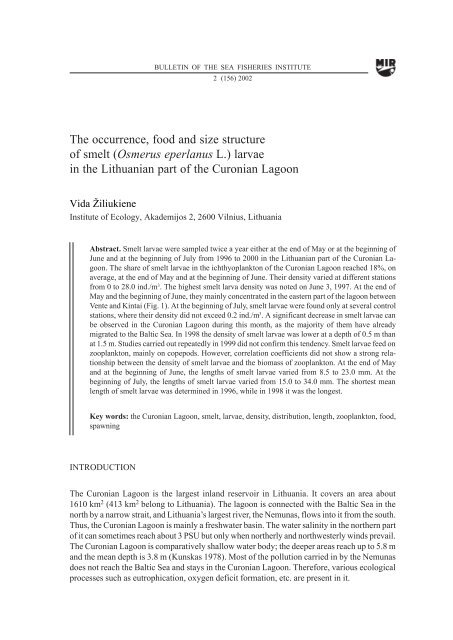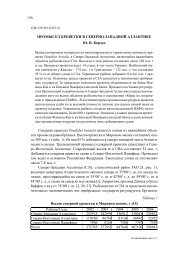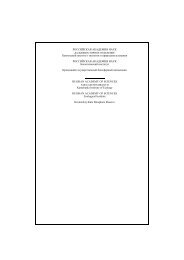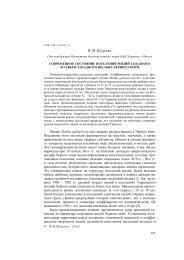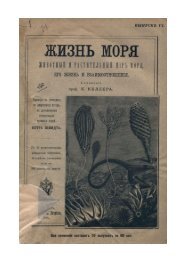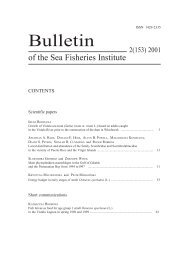Bulletin of the Sea Fisheries Institute 2 (156) 2002 - CEEMaR
Bulletin of the Sea Fisheries Institute 2 (156) 2002 - CEEMaR
Bulletin of the Sea Fisheries Institute 2 (156) 2002 - CEEMaR
You also want an ePaper? Increase the reach of your titles
YUMPU automatically turns print PDFs into web optimized ePapers that Google loves.
BULLETIN OF THE SEA FISHERIES INSTITUTE<br />
2 (<strong>156</strong>) <strong>2002</strong><br />
The occurrence, food and size structure<br />
<strong>of</strong> smelt (Osmerus eperlanus L.) larvae<br />
in <strong>the</strong> Lithuanian part <strong>of</strong> <strong>the</strong> Curonian Lagoon<br />
Vida Žiliukiene<br />
<strong>Institute</strong> <strong>of</strong> Ecology, Akademijos 2, 2600 Vilnius, Lithuania<br />
Abstract. Smelt larvae were sampled twice a year ei<strong>the</strong>r at <strong>the</strong> end <strong>of</strong> May or at <strong>the</strong> beginning <strong>of</strong><br />
June and at <strong>the</strong> beginning <strong>of</strong> July from 1996 to 2000 in <strong>the</strong> Lithuanian part <strong>of</strong> <strong>the</strong> Curonian Lagoon.<br />
The share <strong>of</strong> smelt larvae in <strong>the</strong> ichthyoplankton <strong>of</strong> <strong>the</strong> Curonian Lagoon reached 18%, on<br />
average, at <strong>the</strong> end <strong>of</strong> May and at <strong>the</strong> beginning <strong>of</strong> June. Their density varied at different stations<br />
from 0 to 28.0 ind./m 3 . The highest smelt larva density was noted on June 3, 1997. At <strong>the</strong> end <strong>of</strong><br />
May and <strong>the</strong> beginning <strong>of</strong> June, <strong>the</strong>y mainly concentrated in <strong>the</strong> eastern part <strong>of</strong> <strong>the</strong> lagoon between<br />
Vente and Kintai (Fig. 1). At <strong>the</strong> beginning <strong>of</strong> July, smelt larvae were found only at several control<br />
stations, where <strong>the</strong>ir density did not exceed 0.2 ind./m 3 . A significant decrease in smelt larvae can<br />
be observed in <strong>the</strong> Curonian Lagoon during this month, as <strong>the</strong> majority <strong>of</strong> <strong>the</strong>m have already<br />
migrated to <strong>the</strong> Baltic <strong>Sea</strong>. In 1998 <strong>the</strong> density <strong>of</strong> smelt larvae was lower at a depth <strong>of</strong> 0.5 m than<br />
at 1.5 m. Studies carried out repeatedly in 1999 did not confirm this tendency. Smelt larvae feed on<br />
zooplankton, mainly on copepods. However, correlation coefficients did not show a strong relationship<br />
between <strong>the</strong> density <strong>of</strong> smelt larvae and <strong>the</strong> biomass <strong>of</strong> zooplankton. At <strong>the</strong> end <strong>of</strong> May<br />
and at <strong>the</strong> beginning <strong>of</strong> June, <strong>the</strong> lengths <strong>of</strong> smelt larvae varied from 8.5 to 23.0 mm. At <strong>the</strong><br />
beginning <strong>of</strong> July, <strong>the</strong> lengths <strong>of</strong> smelt larvae varied from 15.0 to 34.0 mm. The shortest mean<br />
length <strong>of</strong> smelt larvae was determined in 1996, while in 1998 it was <strong>the</strong> longest.<br />
Key words: <strong>the</strong> Curonian Lagoon, smelt, larvae, density, distribution, length, zooplankton, food,<br />
spawning<br />
INTRODUCTION<br />
The Curonian Lagoon is <strong>the</strong> largest inland reservoir in Lithuania. It covers an area about<br />
1610 km 2 (413 km 2 belong to Lithuania). The lagoon is connected with <strong>the</strong> Baltic <strong>Sea</strong> in <strong>the</strong><br />
north by a narrow strait, and Lithuania’s largest river, <strong>the</strong> Nemunas, flows into it from <strong>the</strong> south.<br />
Thus, <strong>the</strong> Curonian Lagoon is mainly a freshwater basin. The water salinity in <strong>the</strong> nor<strong>the</strong>rn part<br />
<strong>of</strong> it can sometimes reach about 3 PSU but only when nor<strong>the</strong>rly and northwesterly winds prevail.<br />
The Curonian Lagoon is comparatively shallow water body; <strong>the</strong> deeper areas reach up to 5.8 m<br />
and <strong>the</strong> mean depth is 3.8 m (Kunskas 1978). Most <strong>of</strong> <strong>the</strong> pollution carried in by <strong>the</strong> Nemunas<br />
does not reach <strong>the</strong> Baltic <strong>Sea</strong> and stays in <strong>the</strong> Curonian Lagoon. Therefore, various ecological<br />
processes such as eutrophication, oxygen deficit formation, etc. are present in it.


